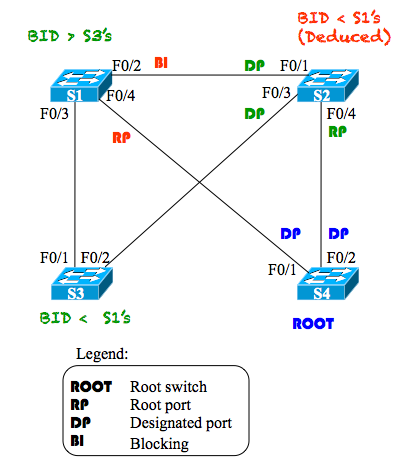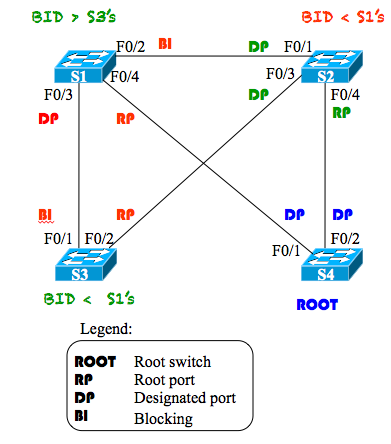STP Puzzle #3 – Answer Part 2
Root Port, Designated Port, and tiebreakers: Today’s #CCNA fun to wrap up this STP puzzle. Today’s post analyzes the rest of this puzzle’s STP roles and states, now that I told you that all the switches use default costs. Enjoy!
- Part 1 of this puzzle
- Part 2 of this puzzle
- All STP Puzzles in the blog
- Overview of how to approach these STP puzzles
- Link to the ICND2 book (to learn more STP)
Quick Review and One Assumption
So, as a quick review… So far, we know for sure that S4 is the root. We also know the STP role for all three relevant interfaces on both S4 and S2, with all of those roles making the three ports on S2 and S4 sit in a forwarding state. Figure 2 summarizes those roles.
Figure 2 – Known Information before Considering Port Costs

This next part of the discussion finds all other port roles and states, by assuming the following:
- All ports use default costs (as stated in the previous post)
- All ports autonegotiate to use their best speed (as ignored in the previous post)
On that last point, note that the switches adjust their STP costs to mirror the port’s speed, unless the cost is explicitly configured.
Looking for S1’s Root Port
Of the two switches about which we know little, S1 ha a direct link to the root (S4), and S3 does not. It is a little easier to build from the root outward, so the discussion here starts with S1.
S1 has two obvious paths to reach the root. One path includes two links, at FastE speeds, defaulting to cost 19. The other path has two links at cost 19, as follows:
- S1’s F0/4 = cost 19
- S1’s F0/2 + S2’s F0/4 = Cost 38
Clearly, S1’s better path to root exits S1’s F0/4 port, making that port S1’s root port.
Looking for Role on the Link from S1 to S2
Next, look at the link from S1 to S2. Then remember these two key STP rules about the roles on a given point-to-point link:
- One end is the Designated Port (DP)
- The other end is either a Root Port (RP), or neither an RP nor DP. That is, there are never two DPs on one link.
In this case, S1 already has an RP, and a non-root switch has only one RP. S1’s F0/2 cannot be an RP. Because S2’s F0/1 is already the DP, S1’s F0/2 cannot be a DP. So the only possible option that matches the known facts is for S1’s F0/2 to be neither RP nor DP, which means it falls to a blocking state, as shown in Figure 4.
Figure 4 – S3’s Role/State on Links to S4 and S2

STP of course did not go through all this detective work. Instead:
- S2 advertised a Hello, with root cost 19, onto the link
- S1 advertised a Hello, with root cost 19, onto the link
- S2 won the tiebreaker, meaning that S2’s Bridge ID (BID) must happen to be numerically lower than S1’s.
The problem didn’t tell us whether S1 or S2 had a lower BID, but it did give enough info to tell us which switch won the DP election.
Looking for S3’s Root Port
Now that most of the details on S1 are settled, next think about S3. It has two two-link paths to root, and two three-link paths to root. With all default cost of 19, the two two-link paths tie at cost 19, as follows:
- S3’s F0/1 + S1’s F0/4 = cost 38
- S3’s F0/2 + S2’s F0/4 = Cost 38
So, what’s the tiebreaker in this case? The same tiebreaker used to choose the DP on the S1-S2 link: The lowest BID of the neighboring switch. We already know from the S1-S2 link that S2 won the battle to be DP, based on the lowest BID tiebreaker. S3 bases it choice of RP on those same BIDs, and S2’s BID is numerically lower than S1’s BID. S3 then chooses its F0/2 as its RP.
Looking for Role on the Link from S3 to S1
The final step looks at the roles on the link between S3 and S1. This one is relatively easy, if you remember the root path and root cost analysis on each. By way of review, both S1 and S3 will at some point forward Hellos onto that link, listing their own root cost. The Hello with the lower root cost wins, and that switch becomes the DP. In this case:
- S1 root path: R1’s F0/4 port, cost 19
- S3 root path: S3’s F0/2 port + S2’s F0/4 port, cost 38
S1 wins, and S1’s F0/3 becomes the DP on the S1-S3 link. S3 loses, and is neither DP nor RP on the link, and falls to a blocking state, as shown in figure 5.
Figure 5 – S3’s Role/State on All Links

So, for those of you who read this far… any variations on this theme that you’d like to see next time?

These are great, Wendell. Thank you!
Thanks!
Beautiful example. Thanks. Got me!
Hi, I’ve issues knowing which side of the link gets the Blocking state, and which gets the DP. Is there any rule of the thumb to know?. Also , had issues understanding why S2 BID < S1 BID
Hi Ben,
Sure. BTW, if you have the CCNA 200-301 Cert Guides, it’s described in detail in Chapter 9. In short, with two switches on a link, the winner is the switch with the lowest root cost. If that’s a tie, it’s the switch with the lowest bridge ID.
Knowing now that S4 is the root, and the claim in the exercise’s first post that all ports use default costs, you can cobble together the result that S2 BID < S1 BID. As follows: with default costs, the FastE ports have cost 19. S1 and S2 root cost will be 19, so their root costs will tie. The winner of which becomes the DP is the switch with the lower bridge ID. We know from information given that S2 wins. Therefore, S2 BID must be lower than S1 BID. Wendell
This one was really great to practice the rules. Thank you!
I have a question (or two) about rule 1 to determine the designated port on any link:
How can a switch not be sending STP Hellos in a point-to-point link?
Can we just skip this rule and go to the second one? (2. the switch advertising the lowest root cost wins)
Angel,
If two switches connect to the link, both will send Hellos. But if the switch port connects to a PC, the PC will not send a Hello or any other STP message. That’s the case for rule 1.